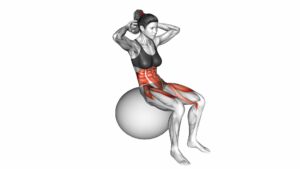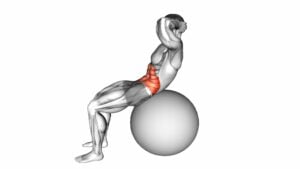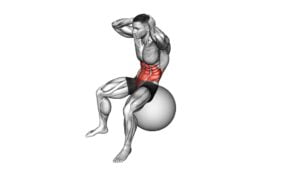V-Up Down (With Stability Ball) – Video Exercise Guide & Tips

Get ready to strengthen your core with V-Up Downs!
Watch This Exercise Video
In this video exercise guide, you'll discover the benefits of incorporating a stability ball into your routine. With just a few simple modifications and progressions, you'll be able to challenge yourself and take your fitness to new heights.
Plus, we'll share tips on how to make the most out of your V-Up Down workout. Are you ready to feel the burn and achieve a stronger, more toned midsection?
Let's get started!
Key Takeaways
- V-Up Downs with Stability Ball engage multiple muscle groups including abs, hip flexors, and lower back muscles.
- The use of a stability ball adds instability, increasing core muscle activation and improving overall stability and balance.
- V-Up Downs target both upper and lower abs, as well as obliques, providing a comprehensive ab workout for a defined core.
- Modifications and progressions, such as bent knees or adding weights, allow for customization and continuous challenge to the core muscles.
Benefits of V-Up Downs With Stability Ball
Get stronger abs and improve your core stability with V-Up Downs using a stability ball. This exercise offers numerous advantages and is highly effective in targeting your abdominal muscles.
One of the key benefits of V-Up Downs with a stability ball is that it engages not only your abs but also your hip flexors and lower back muscles, resulting in a more comprehensive core workout. By using a stability ball, you add an element of instability, forcing your core muscles to work harder to maintain balance and control. This increased challenge leads to greater muscle activation and improved core strength.
In addition to strengthening your abs, V-Up Downs with a stability ball also help to improve your overall stability and balance. As you perform the exercise, you must engage your core muscles to prevent yourself from rolling off the ball. This constant activation of your core muscles helps to enhance your stability and balance, making everyday movements and activities easier and more controlled.
Furthermore, V-Up Downs with a stability ball are a highly effective exercise for targeting your abdominal muscles. The movement involves a combination of a crunch and a leg lift, which activates both your upper and lower abs, as well as your obliques. This comprehensive ab workout helps to tone and strengthen your entire midsection, giving you a more defined and sculpted core.
In summary, incorporating V-Up Downs with a stability ball into your workout routine offers numerous advantages and is highly effective in strengthening your abs and improving your core stability. By adding an element of instability, this exercise challenges your core muscles for enhanced muscle activation and increased strength.
Additionally, it helps to improve overall stability and balance, making everyday movements easier and more controlled. With its ability to target multiple muscle groups in your abdominal region, V-Up Downs with a stability ball provide a comprehensive ab workout for a more defined and sculpted core.
Equipment Needed for V-Up Downs
To perform V-Up Downs with a stability ball, you'll need a stability ball as the main piece of equipment. Stability ball exercises are great for core strengthening workouts, and the V-Up Down is no exception. The stability ball adds an extra challenge to this exercise by requiring you to stabilize your body while performing the movement.
When choosing a stability ball, make sure it's the right size for your height. Most stability balls come in different sizes, so be sure to consult a sizing chart to find the perfect fit. It's important to have a stable and inflated ball to ensure safety and effectiveness during your workout.
In addition to the stability ball, you may also want to have a mat or soft surface to lie on while performing V-Up Downs. This will provide cushioning and support for your back and tailbone.
Remember, proper form is key when performing V-Up Downs with a stability ball. Engage your core muscles and use controlled movements to avoid injury. As you progress, you can increase the difficulty by using a larger stability ball or adding weights to your hands or ankles.
Proper Technique for V-Up Downs
To execute V-Up Downs with a stability ball, you'll need to focus on maintaining proper form and engaging your core muscles throughout the exercise. This will ensure that you get the most out of the workout and avoid any potential injuries.
One common mistake that people make is using momentum to swing their legs up and down, rather than using their abdominal muscles to control the movement. To avoid this, start by lying on your back with the stability ball between your feet and hands extended overhead. Engage your core and lift your legs and upper body off the ground simultaneously, bringing the stability ball towards your feet. Slowly lower yourself back down, keeping your core engaged and controlling the movement.
Another variation of the V-Up Down exercise is to use a weighted medicine ball instead of a stability ball. This adds an extra challenge and helps to further strengthen your core muscles. Remember to start with a weight that's appropriate for your fitness level and gradually increase as you become stronger.
Modifications and Progressions for V-Up Downs
For modifications and progressions of V-Up Downs, you can incorporate different variations and increase the difficulty level to challenge your core muscles even further. Here are some options to consider:
- Modified V-Up Downs: If you find the traditional V-Up Downs too challenging, you can modify the exercise by bending your knees and placing your feet flat on the ground. This will provide more stability and make it easier to lift your upper body off the ground.
- Weighted V-Up Downs: To increase the intensity of the exercise, you can add weights. Hold a dumbbell or a medicine ball in your hands while performing the V-Up Downs. This will engage your core muscles and make them work harder.
- Single-Leg V-Up Downs: To target your core muscles even more, try doing the V-Up Downs with one leg extended in the air while the other leg remains bent. This variation adds an extra challenge and requires more stability and strength.
By incorporating these modifications and variations, you can keep your V-Up Downs routine interesting and continuously challenge your core muscles.
Remember to start with the modification that suits your fitness level and gradually progress to more advanced variations as you become stronger. Keep pushing yourself and you'll see improvements in your core strength and stability.
Tips for Getting the Most Out of Your V-Up Down Workout
To maximize the effectiveness of your V-Up Down workout, focus on maintaining proper form and engaging your core muscles throughout the entire exercise. This will help you increase your core strength and get the most out of your workout. Here are some tips to help you achieve this:
- Start with the basics: If you're new to V-Up Downs, begin by mastering the basic movement without a stability ball. Once you feel comfortable, you can progress to using the stability ball.
- Engage your core: Throughout the exercise, focus on contracting your abdominal muscles and pulling your belly button towards your spine. This will help you activate your core and maximize the benefits of the workout.
- Control your movements: Avoid using momentum to perform the exercise. Instead, focus on controlled movements, both on the way up and on the way down. This will help you engage your core muscles more effectively.
- Explore variations: Once you've mastered the basic V-Up Down, try incorporating variations to challenge your core even further. You can try adding a twist at the top of the movement or extending your legs out as you lower yourself down.
Frequently Asked Questions
How Many Calories Can You Burn by Doing V-Up Downs With a Stability Ball?
You can burn a significant amount of calories by doing v-up downs with a stability ball. These exercises engage your core muscles and increase your heart rate, resulting in calorie burning.
The stability ball adds an extra challenge, making your muscles work harder and increasing the intensity of the workout. Incorporating stability ball in v-up downs not only helps you burn calories but also improves your balance, coordination, and overall core strength.
Keep pushing yourself and reap the benefits!
What Are Some Common Mistakes to Avoid While Performing V-Up Downs With a Stability Ball?
When performing V-Up Downs with a stability ball, it's important to be aware of common mistakes to avoid. Proper form is key to maximizing the effectiveness of this exercise.
Some common mistakes include using momentum instead of engaging your core, not fully extending your legs or reaching for the ball with your hands, and not maintaining stability throughout the movement.
Can V-Up Downs With a Stability Ball Help Reduce Belly Fat?
V-Up Downs with a stability ball can definitely help reduce belly fat. By engaging your core muscles and challenging your balance, this exercise burns calories and strengthens your abdominal muscles.
Plus, the stability ball adds an extra level of difficulty, forcing your body to work harder. To make it more challenging, you can try different variations of V-Up Downs with a stability ball, like adding a twist or extending your arms overhead.
How Many Sets and Repetitions Should Be Performed for an Effective V-Up Down Workout?
To have an effective V-Up Down workout, it's important to know how many sets and repetitions to perform. Before you start, make sure to warm up properly.
V-Up Downs with a stability ball can help reduce belly fat, and they offer many other benefits too.
For an effective workout, aim for 3-4 sets of 10-15 repetitions. Remember to maintain proper form and challenge yourself to push harder each time.
Stay motivated and see the results!
Are There Any Specific Warm-Up Exercises Recommended Before Starting a V-Up Down Workout With a Stability Ball?
Before starting a v-up down workout with a stability ball, it's important to warm up your body properly. Engaging in warm-up exercises like arm circles, jumping jacks, and high knees can help increase blood flow, loosen up muscles, and prepare you for the workout ahead.
Additionally, using a stability ball adds an extra challenge to your v-up down exercises, helping to improve core strength, balance, and stability.
Conclusion
Incorporating V-Up Downs with a stability ball into your workout routine offers numerous benefits, including improved core strength and stability. This exercise requires minimal equipment and can be easily modified or progressed to suit your fitness level.
By following the proper technique and implementing these tips, you can maximize the effectiveness of your V-Up Down workout. Get ready to challenge yourself and see amazing results with this dynamic exercise.

Author
Years ago, the spark of my life’s passion ignited in my mind the moment I stepped into the local gym for the first time. The inaugural bead of perspiration, the initial endeavor, the very first surge of endorphins, and a sense of pride that washed over me post-workout marked the beginning of my deep-seated interest in strength sports, fitness, and sports nutrition. This very curiosity blossomed rapidly into a profound fascination, propelling me to earn a Master’s degree in Physical Education from the Academy of Physical Education in Krakow, followed by a Sports Manager diploma from the Jagiellonian University. My journey of growth led me to gain more specialized qualifications, such as being a certified personal trainer with a focus on sports dietetics, a lifeguard, and an instructor for wellness and corrective gymnastics. Theoretical knowledge paired seamlessly with practical experience, reinforcing my belief that the transformation of individuals under my guidance was also a reflection of my personal growth. This belief holds true even today. Each day, I strive to push the boundaries and explore new realms. These realms gently elevate me to greater heights. The unique combination of passion for my field and the continuous quest for growth fuels my drive to break new ground.



